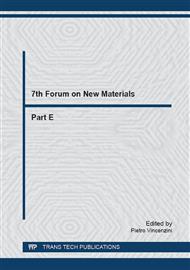p.45
p.55
p.62
p.71
p.79
p.89
p.95
p.104
p.112
Shape Memory Alloys Wires: From Small to Medium Diameter
Abstract:
The use of Shape Memory Alloys in dampers devices able to reduce the wind, rain or traffic induced oscillations in stayed cables is well represented in the literature. An analysis realized on standard cables at existing facilities shows the reliable efficiency of the SMA wire in damping oscillations. Such studies also provide tools to build the SMA dampers and to account for the effects of the external temperature in the SMA. The particular study reported in this paper focuses on a critical discussion on the relation between the wire diameter and macroscopic behavior and external temperature effects. The damping requires the absorption of the mechanical energy and its conversion to heat via the action of hysteresis cycles. The study was realized on wires of different diameters. In particular, the study centers on wires of diameter 0.2, 0.5 and 2.46 mm. The flat cycles showed by the thin wires (i.e., diameter 0.2 and 0.5 mm) and the non-classical S-shaped cycles of wires of diameter 2.46 mm establish clear differences of the response under external summer-winter temperature actions. Depending of the room temperature and SMA composition, a complete flat transformation in thin wires requires stresses, in general, near 300-400 MPa. A complete transformation for an S-shaped cycle need stresses as higher as 600 MPa. The analysis of the behavior of these wires under the action of warm temperatures in summer and cold temperatures in winter, suggests that thin wires lose their pseudo-elastic state in winter. The S-shaped permits positive working in extended temperature domain and a supplementary investigation establishes that S-shaped can be increased by strain aging. The hysteretic behavior in S-shaped permits practical working under external temperatures as applications in bridges require. From a fundamental point of view, the flat cycles are coherent with the classical treatment of the SMA as a first order phase transition but the S-shaped can be considered associated to an anomaly in heat capacity.
Info:
Periodical:
Pages:
79-88
Citation:
Online since:
October 2016
Authors:
Price:
Сopyright:
© 2017 Trans Tech Publications Ltd. All Rights Reserved
Share:
Citation:


